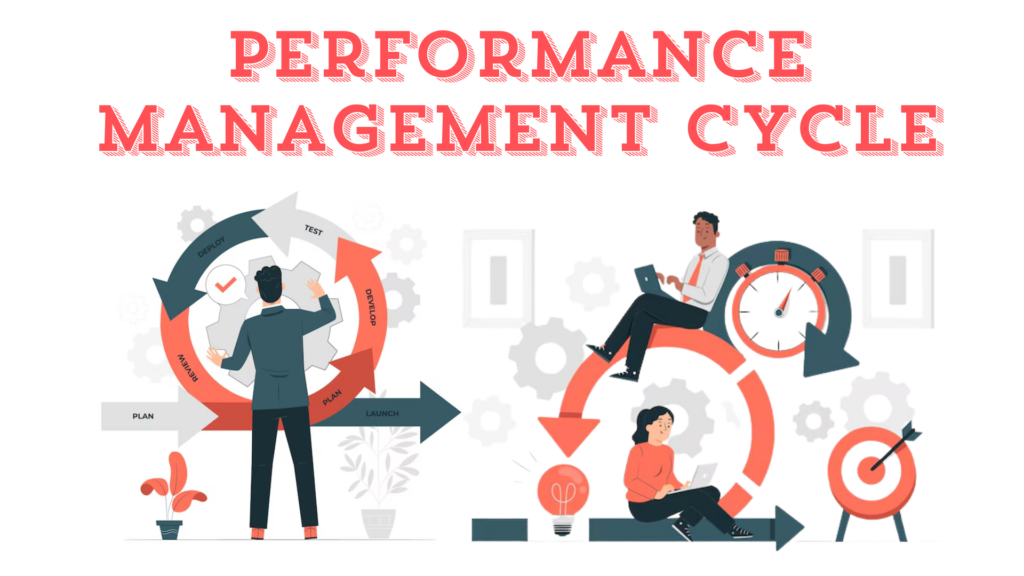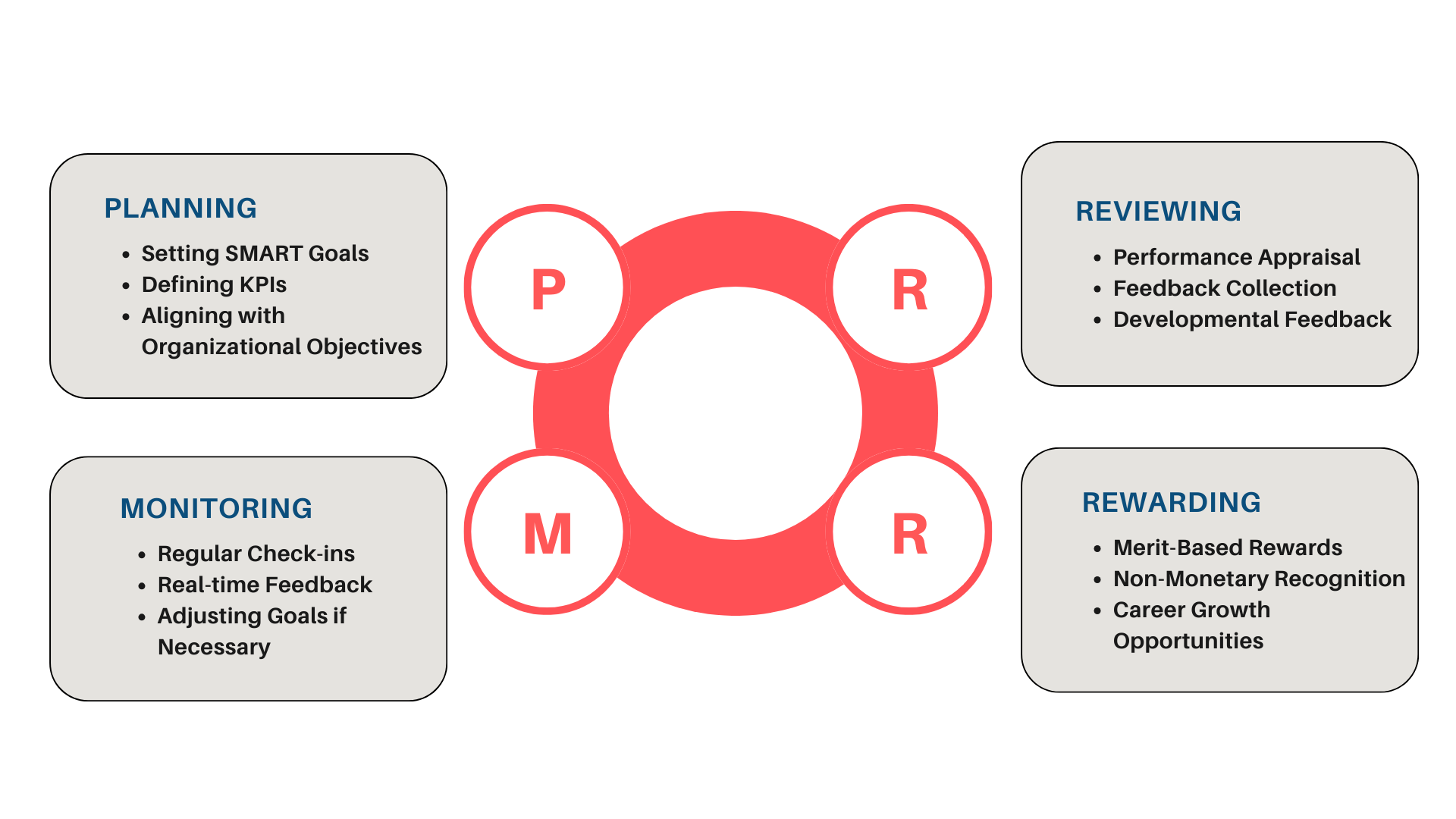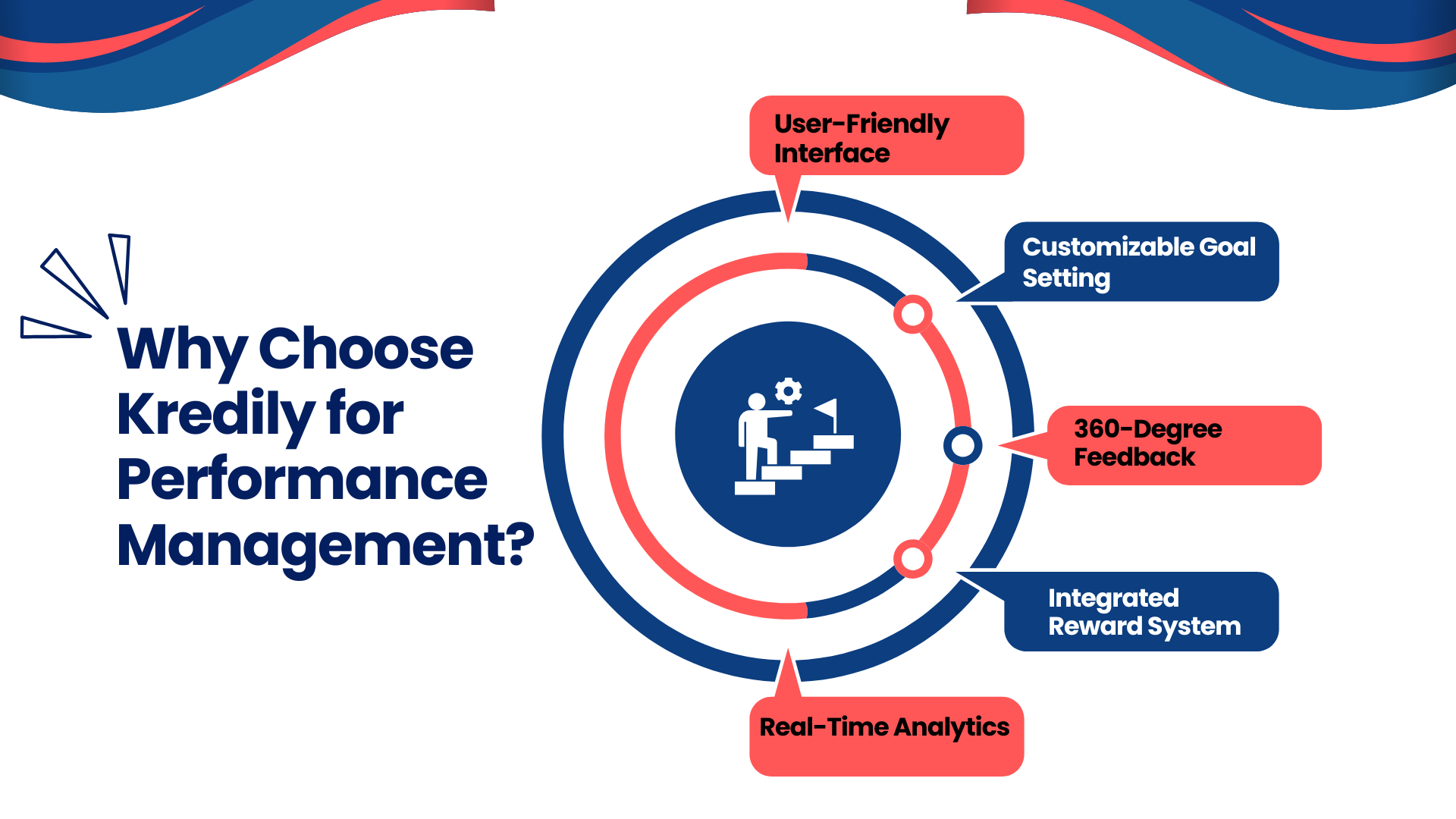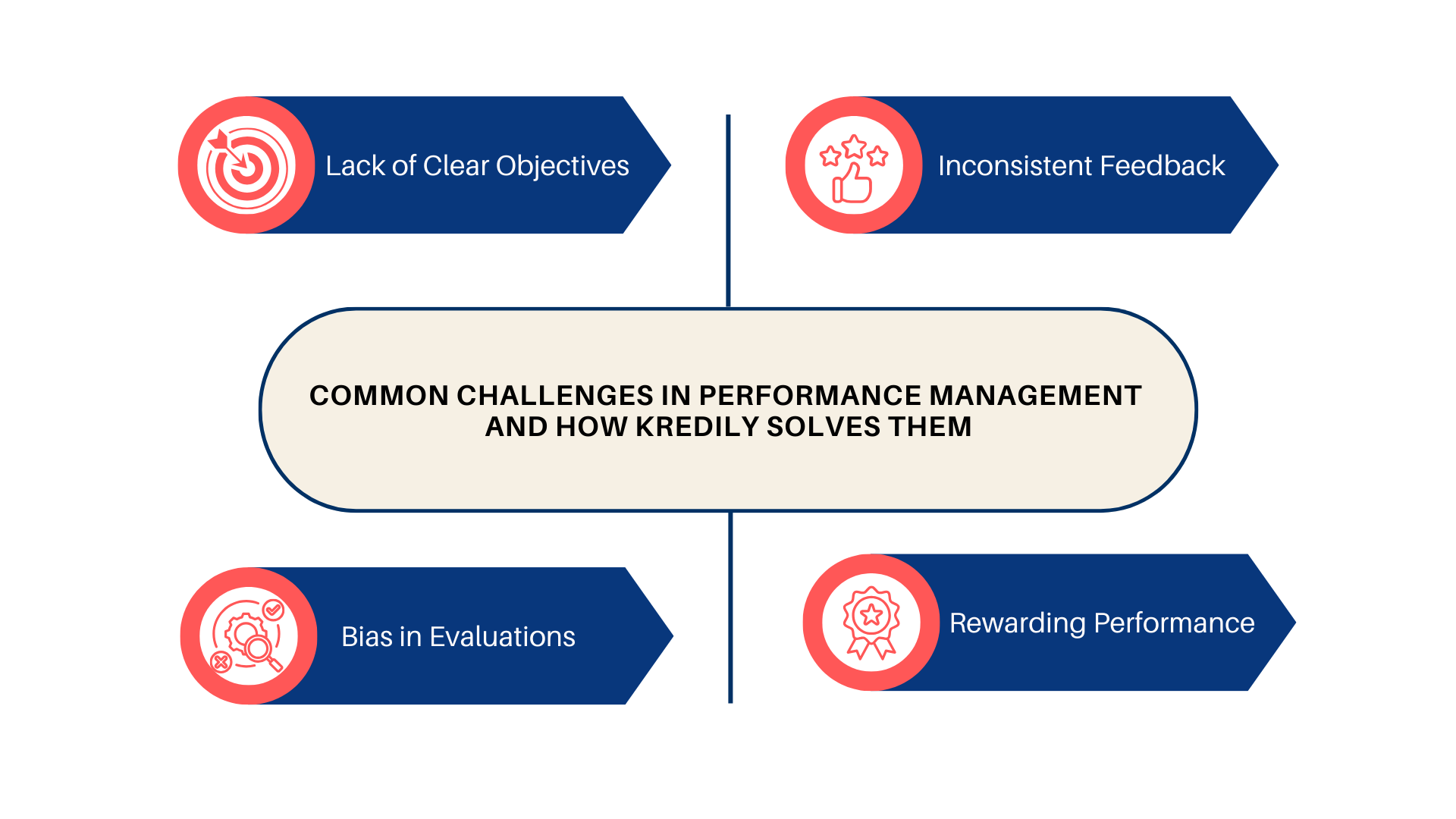Employee performance management is among the most important determinants of success in the current world of operations competition. The best strategy of going about this is by improving a performance management cycle. Effective cycle enables managers establish a clear link between the staff’s performance and the corporate organizational goals thus improving performance and productivity.
In this blog, we’ll discuss what the performance management cycle entails and then discuss each of the phases listed above as it relates to how Kredily can make this crucial function more effective for today’s HR department.
What is the performance management cycle?
The performance management cycle is the continuous cycle practiced in the organizations to appraise the employee efficiencies. Unlike more rigid conventional annual or bi-annual formal performance evaluations, the cycle is utilized as a series of more frequent, structured plans of evaluating, communicating with, and redesigning the behaviors of the employees for the purposes of maintaining motivation and better organization of work in line with the company objectives.
A typical performance management cycle comprises four key stages:
- Planning
- Monitoring
- Reviewing
- Rewarding
Let’s dive into each stage and understand its significance in driving employee performance.
1. Planning: Setting the Foundation for Success
The planning phase is the first step in the performance management cycle, where managers and employees set specific, measurable, achievable, relevant, and time-bound (SMART) goals. These goals are consistent with organizational goals, which means that every worker is aware of and actively part of the total vision.
Key elements of the Planning Phase
- Setting SMART Goals: Specific, Measurable, Achievable, Relevant, and Time-bound objectives help employees understand what is expected of them.
- Defining KPIs: Key Performance Indicators (KPIs) help quantify employee performance and track progress.
- Aligning with Organizational Objectives: Goals should directly support the company’s mission and objectives to ensure each employee’s work has a meaningful impact.
How Kredily Can Help: Kredily’s HRMS software gives the managers the platform to set goals and assign KPIs to the workers so that everyone gets to read from the same script. This feature is especially useful to reduce the time spent on the planning phase of the project to ensure that goals set are in line with organisational objectives.
2. Monitoring: Tracking Progress and Offering Feedback
The monitoring phase focuses on tracking employee performance and offering continuous feedback. This phase emphasizes regular check-ins rather than waiting for an annual review. Monitoring enables managers to identify potential issues early on, provide guidance, and keep employees motivated.
Key elements of the Monitoring Phase
- Regular Check-ins: Scheduled one-on-one meetings between managers and employees foster open communication and build trust.
- Real-time Feedback: Providing immediate feedback on performance helps employees make necessary adjustments promptly.
- Adjusting Goals if Necessary: Flexibility is crucial. If an employee’s goals are no longer aligned with the company’s direction, adjustments can be made to ensure they are working on the most impactful tasks.
How Kredily Can Help: Managers can give feedback and evaluate performers in real-time, so real-time performance tracking and feedback options are available to users of Kredily. This helps retain employees and also give them the opportunity to readjust on something which can lead to a better level of performance.
To further streamline performance evaluations, organizations can use an online assessment platform, which allow for structured, data-driven assessments of employee performance, ensuring fair and objective evaluations while identifying areas for improvement efficiently.
3. Reviewing: Evaluating Performance and Identifying Areas for Improvement
The reviewing phase is whereby there is a total appraisal of the performance of employees in regard to any set goals and KPIs in the planning phase. Appraisal is vital since it exposes the manager to the best performers, areas of the staff shortage, and the foundation for future training.
Key elements of the Reviewing Phase
- Performance Appraisal: A structured performance appraisal provides an objective view of the employee’s contributions and achievements.
- Feedback Collection: Gathering feedback from peers and team members can provide valuable insights and make the review process more well-rounded.
- Developmental Feedback: Constructive feedback is essential for growth. Managers should highlight both strengths and areas where the employee can improve.
How Kredily Can Help: Kredily’s performance review tools ensure the process of performance review is regimented and clear. Regarding the 360-degree feedback options, the managers can get the feedback from different levels, which give them more objective vision of the employee perform
4. Rewarding: Recognizing and Motivating Top Performers
The last but not the least of the performance management cycle is reward. This phase deals with the identification and reward for employees in order to appreciate their efforts made towards their duties. Appreciation inspires the workers and fosters healthy corporate culture where productivity takes centre stage.
Key elements of the Rewarding Phase
- Merit-Based Rewards: Incentives such as bonuses, promotions, or public recognition can motivate employees to keep performing at their best.
- Non-Monetary Recognition: Not all rewards have to be financial. Praising employees publicly or giving them additional responsibilities can also have a positive impact.
- Career Growth Opportunities: Offering learning and development opportunities can be a powerful motivator and show employees that their growth is valued.
How Kredily Can Help
Kredily has tools that help organisations design a performance-linked reward program easily. The platform may also define and assign non-financial rewards wherein the recipient may receive any of the mentioned forms of reward.
Benefits of a Well-Defined Performance Management Cycle
A structured performance management cycle offers several advantages for organizations and employees alike:
- Improved Productivity: The feedback combined with the daily or weekly check-up consequences make the employees more productive since they track themselves.
- Employee Development: Employee appreciation makes the employees advance in their careers boosting general satisfaction in the positions.
- Better Alignment with Company Goals: Organizational goals when communicated effectively and regularly accompanied by appraisals. The workers’ efforts being directed towards activities that benefit the organization.
- Higher Employee Retention: Whenever employees get feedback and believe that the company cares for them, they end up remaining with the firm.
Why Choose Kredily for Performance Management?
Kredily provides a complete packaged HRMS solution where all Performance Management systems can be managed easily. Here’s how Kredily stands out:
- User-Friendly Interface: The platform is relatively intuitive so both the employees and the managers find it easy to use it as demonstrated by Kredily.
- Customizable Goal Setting: Set organisational specific goals for the employees based on the employees’ ability or position.
- 360-Degree Feedback: You should however compile information from different sources in order to get a balanced review of the facts.
- Integrated Reward System: With Kredily you can automate and monitor performance related incentives to ensure loyalty from the employees.
- Real-Time Analytics: Have easy access to the required reports and analytics so as to be in a position to make good decisions.
Performance Management Cycle vs. Traditional Annual Appraisals
Unlike traditional annual performance reviews, which are often one-sided and limited to once a year, the performance management cycle encourages ongoing feedback and growth. This modern approach enhances manager-employee communication, fosters continuous improvement, and aligns teams with organizational goals for greater success.
Key Differences
| Traditional Appraisals | Performance Management Cycle |
| Occurs once a year | Ongoing process with regular feedback |
| Limited feedback scope | 360-degree feedback from peers, managers |
| Focus on past performance | Emphasis on continuous improvement |
| Minimal employee involvement | Employee participation in goal setting |
Common Challenges in Performance Management and How Kredily Solves Them
Managing employee performance isn’t without challenges. Here are some common hurdles and how Kredily’s HRMS addresses them:
- Lack of Clear Objectives: When the goals are set vague then people get confused. In this area, Kredily assists by supporting SMART organizational goals so that employees will know what to accomplish.
- Inconsistent Feedback: Delayed feedback is unhelpful in the process of correction and enhancement. The features of giving feedback in real-time serve Kredily the best by ensuring that employees receive guidance when it is most useful.
- Bias in Evaluations: Evaluations that include the opinions and feelings of the workers are a negative thing. In a way, Kredily has a 360-degree feedback system to avoid subjective feedback and task the job in a more well-balanced manner.
- Rewarding Performance: Rewarding is also crucial in the course of migration since there must be ways of identifying deserving employees. Kredily needs to ensure that there is an integrated reward system that can facilitate quick identification of high performers for a reward.
Conclusion
A well-defined performance management cycle is essential for fostering a culture of continuous improvement, productivity, and engagement. By following the cycle’s four phases—planning, monitoring, reviewing, and rewarding—organizations can ensure that employees remain aligned with business goals and stay motivated.
With Kredily’s HRMS solution, managing each phase of the performance cycle becomes seamless. Kredily’s platform offers tools for goal-setting, real-time feedback, comprehensive reviews, and reward management, making it an ideal choice for businesses of all sizes.




